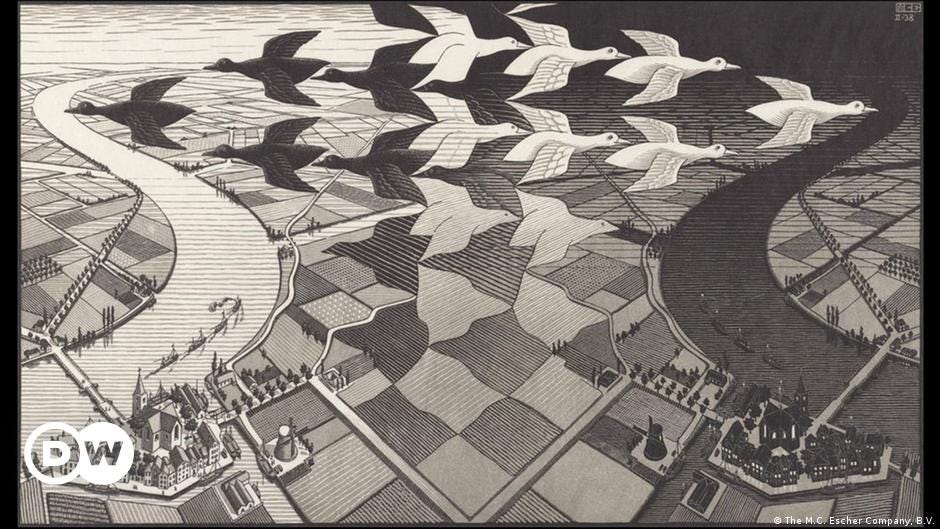Week 2: Math + Art
Mathematics can be used in art in several ways, including symmetry, geometry, proportion, and balance. In the article "Art and Math: Aesthetics of Calculation" by Ferreira, it is explained how the link between math and art dates back several centuries, playing an important role during the Renaissance when math was used to make artworks more realistic. In the article by Show Me your Math, they explain the link between nature and math. For example, the Fibonacci spiral which is seen in pine cones and shells. Because of the link between nature and math, it makes sense that it is translated into art as much of the inspiration for artworks are realistic elements (nature, people, etc.). In the article "Unveiling the Marvels of Mathematical Art" by Medium, this is further emphasized as they highlight how several artists make use of certain mathematical principles as a signature art style. For example, M.C. Escher is particularly fond of tessellations to create symmetry in much of his works.

In Kandinsky's Composition 8, the artist made use of mathematical forms such as triangles, open and closed lines, and concentric circles. His work is abstract, and math is used in his art as a means of providing some form to his artwork. While his art doesn't attempt to portray something realistic, such as a person or elements of nature, it still uses math to create something that can be seen in real life. These elements (triangles, lines, circles, etc.) are in several aspects of the real world, and Kandinsky portrays them as they are in an artistic manner.

Artists/scientists use mathematics in their creative work/expression by making use of mathematical concepts to guide how they approach their preferred mode of expression. For artists in particular, math is used to artwork that delivers a certain sentiment, both aesthetically and perhaps even emotionally. For instance, an artist may use math to create work that looks realistic while another may use math to create work that is more geometric.

Overall, I would explain that the juxtaposition of math, art, and science is how each plays into certain elements, and how each expresses the same concepts. Math, art, and science all have the ability to attempt to portray and explain aspects of our real, tangible world, but the juxtaposition arrises in how that is expressed — whether it be through numbers, shapes, or color.
Referenced Images:
Image 1: Composition 8 by Kandinsky at Guggenheim Museum
Image 2: Fibonacci sequence in Leonardo da Vinci's Mona Lisa
Image 3: Day and Night by M.C. Escher
References:
Ferreira, Rute. “Art and Math: Aesthetics of Calculations.” DailyArt Magazine, 12 Sept. 2023, www.dailyartmagazine.com/art-and-math/. Accessed 12 Apr. 2024.
“Math in Art and Nature.” Show Me Your Math, 2017, showmeyourmath.ca/outreach/math-in-art-and-nature/. Accessed 12 Apr. 2024.
math, Two-thirds. “Unveiling the Marvels of Mathematical Art.” Medium, 17 June 2023, medium.com/@twothirdsmath/unveiling-the-marvels-of-mathematical-art-76a41a3c44fb. Accessed 12 Apr. 2024.
Patil, Swapnila, et al. “Relation between Math and Art Explained: Superprof.” Superprof, 2023, www.superprof.co.in/blog/maths-help-with-painting/. Accessed 12 Apr. 2024.
“Top 5 Expressions of Mathematics in Art.” Mathematics, 6 Oct. 2023, uwaterloo.ca/math/news/top-5-expressions-mathematics-art. Accessed 12 Apr. 2024.
I discussed several similar themes in my blog this week too, specifically about the use of geometry and symmetry in art. Kandinsky's Composition 8 is a really good example of the use of mathematical principles in art. Before this weeks lesson, I might have regarded this work as truly abstract & random shapes and lines-- but I can agree to now see that mathematical principles are used to make this art piece intentionally. For example perspective, and ratio. Your point that this piece "uses math to create something that can be seen in real life," is a good reflection. I agree that art can bring these concepts alive.
ReplyDelete